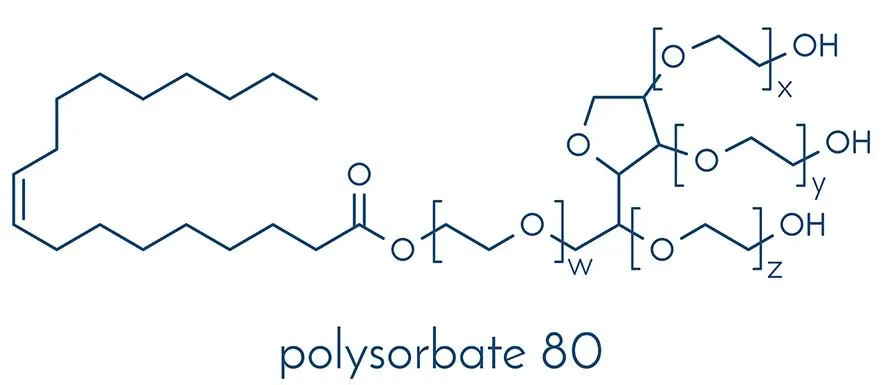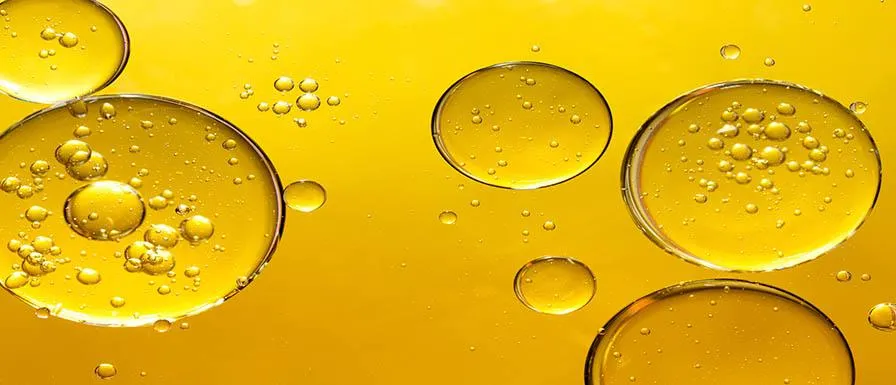Polysorbate 20, 40, 60 and 80
Polysorbates are derived from ethoxylated sorbitan (a derivative of sorbitol) esterified with fatty acids and exist as oily liquids. These Polysorbates belong to the class of emulsifiers used in pharmaceuticals and food preparations (salad dressing, ice cream, chocolates, baked goods and confectionery). They are used in cosmetics to solubilize essential oils into water-based products, pharmaceuticals, detergents, paints, and plastic applications. These Polysorbates surfactants consist primarily of oleic, stearic or lauric fatty acid esters with sorbitol-derived cyclic ethers (sorbitans and sorbides) and further polymerized with approximately 20 molecules of oxirane per molecule of Polysorbates.
- Polysorbate 20 (polyoxyethylene (20) sorbitan monolaurate)
- Polysorbate 40 (polyoxyethylene (20) sorbitan monopalmitate)
- Polysorbate 60 (polyoxyethylene (20) sorbitan monostearate)
- Polysorbate 80 (polyoxyethylene (20) sorbitan monooleate)
The number following the 'polysorbates' part reflects the type of fatty acid connected with the polyoxyethylene sorbitan part of the molecule. Monolaurate is indicated by 20, monopalmitate is indicated by 40, monostearate by 60, and monooleate by 80. The number 20 following the 'polyoxyethylene' part refers to the total number of oxyethylene -(CH2CH2O)- groups found in the molecule.

Polysorbate 20 (commercially called Tween 20) is derived from sorbitol, a natural sugar alcohol and forms a polysorbate-type nonionic surfactant by the ethoxylation of sorbitan (derived from the dehydration of sorbitol) before the addition of lauric acid. Polysorbate 20 is relatively nontoxic and stable therefore can be used as a emulsifier and detergent in a number of domestic, scientific, and pharmacological applications. Tween 20 functions as a good wetting agent having food application in flavoured mouth drops, providing a spreading feeling to other added flavour ingredients. In biochemical applications, polysorbate 20 finds use as washing agent in immunoassays, solubilizing agent for membrane proteins, and lysis solutions for mammalian cells. While in the pharma sector, it functions as an excipient helping to stabilize emulsions and suspensions. The Cosmetics Ingredient Review (CIR) Expert Panel evaluated the scientific data and concluded that polysorbate 20 is safe for use in cosmetic formulations.
Tween 80 (Polysorbate 80) is an amber/golden-colored water-soluble viscous liquid. It is manufactured from polyethoxylated sorbitan (derived from the dehydration of sorbitol, a sugar alcohol) and oleic acid, a fatty acid found in animal and vegetable fats. Due to this structure, polysorbate 80 forms an approximate hydrophilic-lipophilic balance of 15. The final products are free from genetically modified organisms and of vegetable origin. Polysorbate 80 (or E433) is a non-ionic surfactant and emulsifier find use in foods as emulsifier for salad dressings and chocolates, in cosmetics for preparing skin, facial cleansers and hair care products, and to disperse active ingredients in pharmaceuticals benefiting the pharmacological industry.

The solubility of Polysorbate 80 allows it to assist in dissolving ingredients that would remain solid under normal circumstances. In foods like ice cream, Polysorbate 80 is added up to 0.5% (v/v) concentration to make the ice cream smoother and easier to handle, as well as increasing its resistance to melting. Vitamins, tablets, and supplements also contain Polysorbate 80 because of its preservative nature. Polysorbate 80 being a nonionic surfactant is used in soaps and cosmetics (including eyedrops), or as solubilizer in mouthwashes.
In order to get the same wonderful colors you use in your other bath and body products, add Polysorbate 80 at about 2 % (of your total batch) in your liquid stage. This should eliminate any ring around the tub or floating mica that can occur if you don't use it. the full name polyoxyethylene (20) sorbitan monostearate or Polysorbate 60 or Tween 60, is an synthetic ingredient made from reaction of sorbitol, stearic acid (C18) and ethylene oxide. Due to this structure, polysorbate 60 forms an approximate hydrophilic-lipophilic balance of 14.9. The primary use of Tween 60 as an emulsifier in food (number E435) and as a solubilizer & surfactant in cosmetics is well known.
Polysorbate 60 is a synthetic multi-ingredient that can be used as a surfactant, emulsifier, solubilizer, stabilizer in food, cosmetics and personal care products. Polysorbate 60 helps water-based and oil-based ingredients blend easily and prevent their separation in food. Polysorbate 60 and 80 are mostly used in food among the category of Polysorbates, but the latter is used more than polysorbate 60 in food.
Polysorbate 60 and 80 are the most commonly used in bakery food production. They help to extend shelf life, improve the strength and increase volume of baked goods and frozen desserts.
As a high HLB emulsifier, its food grade can be blended with a low HLB emulsifier (e.g. sorbitan stearate, mono and diglycerides) to provide a suitable HLB value for the various food uses, either oil in water, or water in oil emulsion.
Its general purpose in cosmetics is to mix water and oil together. Polysorbate 60 functions as a surfactant, emulsifier, solubilizer and dispersing agent. Some of its applications as follows: Help wash away body dirt by lowering the surface tension on the skin when used in shampoos and body washes. It heps distribute essential oils, fragrances and colorants evenly in water for Lotions, Creams, Hair products, Skin care products and Makeup products.
Polysorbate 60 is safe to consume and has been approved as a safe ingredient by the U.S. Food and Drug Administration (FDA) and European Food Safety Authority (EFSA), as well as the Joint FAO/WHO Expert Committee on Food Additives (JECFA).
